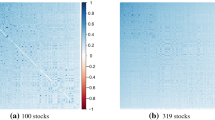Abstract
In this paper, we propose a modified mean-variance portfolio selection model that incorporates the sparse-group lasso (abbreviated as SGLasso) regularization in machine learning. This new model essentially has three merits: first, it allows investors to incorporate their preference over equity sectors when constructing portfolios; second, it helps investors select sectors based on assets’ past performances as it encourages sparsity among sectors; third, it has stabilizing and sparsifying effect on the entire portfolio. We connect our model to a robust portfolio selection problem, and investigate effects of the SGLasso regularization on the optimal strategy both theoretically and empirically. We develop an efficient algorithm to find the optimal portfolio and prove its global convergence. We demonstrate the efficiency of the algorithm through simulated experiments under large datasets and evaluate the out-of-sample performance of our model via empirical tests across different datasets.





Similar content being viewed by others
Notes
FF 25 and FF 100 datasets are complied by Fama and French and can be downloaded from website: “http://mba.tuck.dartmouth.edu/pages/faculty/ken.french/data_library.html”.
References
Best, M., & Grauer, R. (1991). On the sensitivity of mean-variance efficient portfolios to changes in asset means: Some analytical and computational results. Review of Financial Studies, 4(2), 315–342.
Bjerring, T. T., Ross, O., & Weissensteiner, A. (2017). Feature selection for portfolio optimization. Annals of Operations Research, 256(1), 21–40.
Boyd, S., Parikh, N., Chu, E., Peleato, B., & Eckstein, J. (2010). Distributed optimization and statistical learning via the alternating direction method of multipliers. Foundations and Trends in Machine Learning, 3(1), 1–122.
Brodie, J., Daubechies, I., De Mol, C., Giannone, D., & Loris, I. (2009). Sparse and stable Markowitz portfolios. Proceedings of the National Academy of Sciences, 106(30), 12267–12272.
Chopra, V., & Ziemba, W. (1993). The effects of errors in means, variances, and covariances on optimal portfolio choice. Journal of Portfolio Management, 19, 6–11.
Daubechies, I., Defrise, M., & De Mol, C. (2004). An iterative thresholding algorithm for linear inverse problems with a sparsity constraint. Communications on Pure and Applied Mathematics, 57(11), 1416–1457.
De Mol, C. (2016). Sparse Markowitz Portfolios. In A. N. Akansu, S. R. Kulkarni, & D. Malioutov (Eds.), Financial Signal Processing and Machine Learning. Chichester: Wiley.
DeMiguel, V., Garlappi, L., Nogales, F. J., & Uppal, R. (2009). A generalized approach to portfolio optimization: Improving performance by constraining portfolio norms. Management Science, 55(5), 798–812.
DeMiguel, V., Garlappi, L., & Uppal, R. (2007). Optimal versus naive diversification: How inefficient is the 1/N portfolio strategy? The Review of Financial Studies, 22(5), 1915–1953.
Gotoh, J., & Takeda, A. (2011). On the role of norm constraints in portfolio selection. Computational Management Science, 8(4), 323–353.
Fabozzi, F. J., Huang, D., & Zhou, G. (2010). Robust portfolios: Contributions from operations research and finance. Annals of Operations Research, 176, 191–220.
Fazel, M., Pong, T. K., Sun, D., & Tseng, P. (2013). Hankel matrix rank minimization with applications to system identification and realization. SIAM Journal on Matrix Analysis and Applications, 34(3), 946–977.
Friedman, J., Hastie, T., & Tibshirani, R. (2010). A note on the group lasso and a sparse group lasso. arXiv preprint arXiv:1001.0736.
Glowinski, R. (2014). On alternating direction methods of multipliers: A historical perspective. In W. Fitzgibbon, Y. A. Kuznetsov, P. Neittaanmäki, & O. Pironneau (Eds.), Modeling, simulation and optimization for science and technology (pp. 59–82). Dordrecht: Springer.
Jagannathan, R., & Ma, T. (2003). Risk reduction in large portfolios: Why imposing the wrong constraints helps. Journal of Finance, 58(4), 1651–1684.
Kim, J. H., Kim, W. C., Kwon, D. G., & Fabozzi, F. J. (2018). Robust equity portfolio performance. Annals of Operations Research, 266, 293–312.
Kolm, P. N., Tütüncü, R., & Fabozzi, F. J. (2014). 60 Years of portfolio optimization: Practical challenges and current trends. European Journal of Operational Research, 234, 356–371.
Lam, X. Y., Marron, J. S., Sun, D., & Toh, K. C. (2018). Fast algorithms for large scale generalized distance weighted discrimination. Journal of Computational and Graphical Statistics, 27(2), 368–379.F.
Markowitz, H. (1952). Portfolio selection. Journal of Finance, 7(1), 77–91.
Olivares-Nadal, A. V., & DeMiguel, V. (2018). Technical note: A robust perspective on transaction costs in portfolio optimization. Operations Research, 66(3), 733–739.
Rockafellar, R. T., & Wets, R. J. B. (1998). Variational analysis. Berlin: Springer.
Sharma, A., & Mehra, A. (2016). Financial analysis based sectoral portfolio optimization under second order stochastic dominance. Annals of Operations Research, 256(1), 171–197.
Simon, N., Friedman, J., Hastie, T., & Tibshirani, R. (2013). A SGLasso lasso. Journal of Computational and Graphical Statistics, 22(2), 231–245.
Yang, Y., Ahipasaoglu, S. D., & Chen, J. (2017). On the robustness and sparsity trade-off in mean-variance portfolio selection. Available at SSRN https://ssrn.com/abstract=2873037.
Yu, Y. L. (2013). On decomposing the proximal map. In C. J. C. Burges, L. Bottou, M. Welling, Z. Ghahramani & K. Q. Weinberger (Eds.), Advances in neural information processing systems (Vol. 26, pp. 91–99). Curran Associates, Inc.
Yuan, L., Liu, J., & Ye, J. P. (2011). Efficient methods for overlapping group lasso. In J. Shawe-Taylor, R. S. Zemel, P. L. Bartlett, F. Pereira & K. Q. Weinberger (Eds.), Advances in neural information processing systems (Vol. 24, pp. 352–360). Curran Associates, Inc.
Acknowledgements
This research is partially supported by the National Natural Science Foundation of China (NSFC) under Grant KZ73100001 and the Beihang University Research Fund Program under Project ZG216S1871.
Author information
Authors and Affiliations
Corresponding author
Additional information
Publisher's Note
Springer Nature remains neutral with regard to jurisdictional claims in published maps and institutional affiliations.
Rights and permissions
About this article
Cite this article
Chen, J., Dai, G. & Zhang, N. An application of sparse-group lasso regularization to equity portfolio optimization and sector selection. Ann Oper Res 284, 243–262 (2020). https://doi.org/10.1007/s10479-019-03189-z
Published:
Issue Date:
DOI: https://doi.org/10.1007/s10479-019-03189-z




